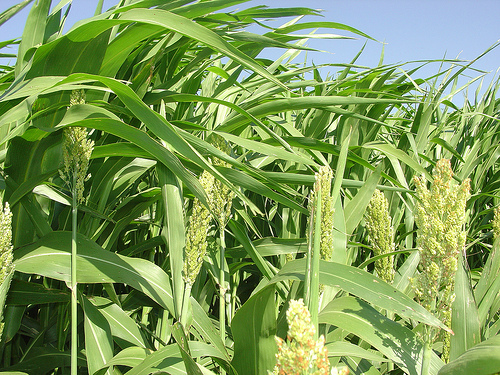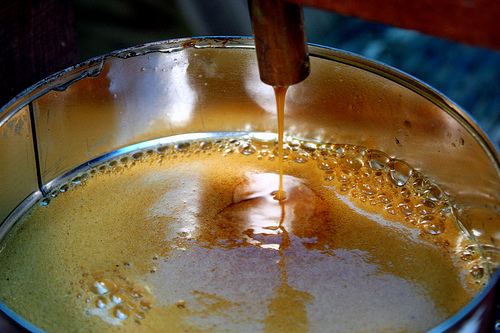Ethanol from Sorghum
The stem juice of sweet sorghum is rich in fermentative sugar and is a desirable fermentation material for the production of ethanol. Primarily grown for silage, forage and sugar production, sorghum is often cited as a promising crop because it costs less to grow than corn and can thrive in conditions that are less than ideal for corn production. In North America, sweet sorghum has been traditionally grown for the syrup or “molasses” made from it. Ethanol production from sweet sorghum is largely still in trial stages in North America but is more widely done in China and India. One of the main challenges is that the sugar has to be fermented immediately. The sorghum molasses cannot be condensed to the point that the sugars crystallize, unlike with sugar cane or sugar beets. Two known prototypes exist[1][2] that squeeze the sorghum stems in the field, however nothing is currently in production. Adapting these designs to be fabricatable on-farm would be an ideal OSE project. Sorghum has a productive advantage over maize under 900 mm annual rainfall conditions but is at a disadvantage with rainfalls of 1000 mm. Missouri receives around 900 mm annual rainfall and sorghum is adapted to these conditions.
Conversion to Ethanol
This first section calculates raw cane juice into ethanol.
- 1 gallon of juice = 3.785 liters.
- 1 liter @ 18 brix = 180 g sugar.
- 80 g sugar -> 92 g EtOH + 88 g CO2 (theoretical yield).
- 92 g EtOH/720 g/l ethanol = .128 liters of ethanol per liter of juice.
- .128 l EtOH x 3.785 l/gal = .484 liters of EtOH per gallon of juice / 3.785.
- 1 gallon of sorghum juice produces .128 gallons of ethanol.
- 7.8125 gallons of sorghum juice produce 1 gallon of ethanol.
The next section calculates the necessary acreage planted in sweet sorghum (central Florida application) to provide feedstock for an ethanol plant.
- A gallon of sorghum juice weighs the same as a gallon of water 8.39 lbs + the weight of the sugar dissolved in the gallon -- ~10 pounds for a 18 brix solution.
- In two years of field trials, the lowest yields per acre, per harvest have been ~30 green (wet) tons per acre.
- Lab analysis of the sweet sorghum reflects (conservatively) a moisture level of 70%.
Links
- Sweet Sorghum Ethanol Association
- economic calculations: Sorganol
- FAO Corporate Document Repository: "Ethanol production from sweet sorghum"
- High desert permaculture: Sorghum for syrup and ethanol
Literature and patent review
[1] "Sweet Sorghum as Feedstock for Ethanol Production: Enzymatic Hydrolysis of Steam-Pretreated Bagass" Bálint Sipos & Jutka Réczey & Zsolt Somorai & Zsófia Kádár & Dóra Dienes & Kati Réczey. Appl Biochem Biotechnol: 30 October 2008 Sorghum has been a crop under human cultivation for sugar production throughout the world currently and for a long period. After pressing for the sugary stem juice a cellulose rich waste known as bagass is leftover. This waste may be burned or further treated to release the linked sugars with a combination of steam and enzymatic hydrolysis treatment. Harvests in September were found to contain the most amount of total and desirable sucrose sugar in the amount of over 100 g/L/. This study used a combination of treatments with separation steps to create a basic refinery process and maximize ethanol yield. Sugar is stored in the stem of the plant and introduction of leaves dilutes the sugar concentration; however, removal of leaves before pressing doesn't appear economical. After initial pressing bagass was treated with steam at 180 C - 200 C and resulted in a slurry of partially digested cellulose and lignin molecules. This slurry was was either treated with a series of cellulases or separated into a soluble supernatant and insoluble fiber fraction, where the insoluble fiber fraction was washed and treated with cellulases. The study found that a steam treatment followed by separation yielded a carbohydrate rich supernatant low in inhibitors and suitable for fermentation, and the fiber pellet. Cellulolytic treatment of the fiber pellet of 190 C 10 min and 200 C 5 min pretreatments resulted in the highest conversion efficiencies of 89% and 92% of total pretreated glucan content.
OSE may incorporate these further processing steps in time, if sorghum becomes a major source of organic material, but initially maximizing sugar yield by optimizing growth and harvest should be the highest priority. The fiber pellet also has properties of high quality paper pulp and could find value this way, while cellulase treatments are prohibitively expensive at the moment.
[2] "Brown midrib mutations and their importance to the utilization of maize, sorghum, and pearl millet lignocellulosic tissues" Scott E. Sattler, Deanna L. Funnell-Harris, Jeffrey F. Pederse. Plant Science: 8 January 2010. Brown midrib mutants (Bmr) strains of sorghum have improved qualities for fermentation and a decrease in lignocellulose content. Bmr strains have been identified through laboratory mutagenesis and as spontaneous mutations as involving either of two key loci for lignin production. caffeic O-methyltransferases (COMT) and cinnamyl alcohol dehydrogenase 2(CAD2) are the two enzymes whose interruption has been linked to a bmr phenotype. Bmr strains are thought to have lower yields than wild-type controls but yields are quite good compared to other hybrid strains. Decreased lignin has been shown to increase availability of sugars for ethanol production and nutritiousness as silage for cattle. Overall sweet sorghum strains with decreased lignin content should be investigated for use as cattle silage and ethanol feedstock.
Hybrid strains are proprietary and there are patents that exist on the genes however the identification of spontaneous mutants since may provide strains that are free of legal claims. OSE should consider how genetic optimization of feedstock crops is a necessary component to high yielding permaculture.
[3] Ethanol and lactic acid production as affected by sorghum genotype and location. X. Zhan, D. Wang, M.R. Tuinstra, S. Bean, P.A. Seib, X.S. Sun. Industrial Crops and Products: 2003 (18).
Lactic acid and ethanol production showed variation of 15% and 5% between the 16 test samples used. Yield of both products was affected by chemical composition and physical properties, but chemical composition has more significant role. Varieties with the highest yields were higher in starch content and lower in protein content, fiber content, glutamic acid content, and kernel hardness and likewise these characteristics were affected by environment and genotype. The study also found much less of an effect by environment on ethanol yield.
[4] Process for preparing and using sweet sorghum in a fuel material. Rudolf Gunnerman and William Farone.
This patent is for methods to store and prepare sweet sorghum for energy production by ethanol fermentation and combustion of lignocellulosic fraction pellets.
[1] Muddy Pond modified sugarcane harvestor [2] Prototype designed by Lee McClune and now owned by 7 elements farm

